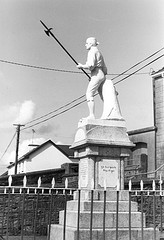Battle of Ballinamuck
This article needs additional citations for verification. (January 2013) |
| Battle of Ballinamuck | |||||||
|---|---|---|---|---|---|---|---|
| Part of the United Irishmen Rebellion | |||||||
 Contemporary plan of the Ballinamuck battle-ground, marking the positions of the opposing forces | |||||||
| |||||||
| Belligerents | |||||||
|
|
| ||||||
| Commanders and leaders | |||||||
| Jean Humbert |
The Marquess Cornwallis Gerard Lake | ||||||
| Strength | |||||||
| ~2,350 | ~26,000 | ||||||
| Casualties and losses | |||||||
|
~500 dead 1,144 captured ~200 prisoners executed |
~12 dead 16 wounded | ||||||
The Battle of Ballinamuck (8 September 1798) marked the defeat of the main force of the French incursion during the 1798 Rebellion in Ireland.
Background
The victory of General Humbert at the Battle of Castlebar, despite gaining him around 5,000 extra Irish recruits, had not led to a renewed outbreak of the rebellion in other areas as hoped; the defeat of the earlier revolt had devastated the Irish republican movement to the extent that few were willing to renew the struggle. A massive British army of some 26,000 men was assembled under the new Viceroy Lord Cornwallis and was steadily moving west. Abandoning Castlebar, Humbert moved towards Ulster with the apparent intention of igniting a rising there but after defeating a blocking force of British troops at Collooney in Sligo, he altered course following reports that rebellions had broken out in Westmeath and Longford.
British pursuit
Humbert crossed the Shannon at Ballintra on 7 September and stopping at Cloone that evening, was halfway between his landing-point and Dublin. News reached him of the defeat of the Westmeath and Longford rebels at Wilson's Hospital School and Granard from the trickle of rebels who had survived the slaughter and reached his camp. With Cornwallis' huge force blocking the road to Dublin, facing constant harassment of his rearguard and the pending arrival of General Lake's command, Humbert decided to make a stand the next day at the townland of Ballinamuck on the Longford/Leitrim border.
Battle
Humbert faced overwhelming numbers. General Lake was close behind with 14,000 men; the new Viceroy, Lord Cornwallis, on his right at Carrick-on-Shannon with 15,000. The battle began with a short artillery duel followed by a dragoon charge on exposed Irish rebels. There was a brief struggle when French lines were reached which only ceased when Humbert signalled his intention to surrender and his officers ordered their men to lay down their muskets. This conventional battle lasted little more than half an hour.
While the French surrender was being taken the 1,000 or so Irish allies of the French under Colonel Teeling, an Irish officer in the French army, held onto their arms without signalling the intention to surrender or being offered terms. An attack by infantry followed by a dragoon charge broke and scattered the Irish who were ruthlessly pursued with much slaughter.
Aftermath

96 French officers and 748 men were taken prisoner. British losses were initially reported as 3 killed and 16 wounded or missing,[1] but the number of killed alone was later reported as 12.[2] Approximately 500 Irish lay dead on the field, 200 prisoners were taken in the mopping up operations, almost all of whom were later hanged, including Matthew Tone, brother of Wolfe Tone. The prisoners were moved to Carrick-on-Shannon, St Johnstown, today's Ballinalee, where most were executed in what is known locally as Bully's Acre.
Humbert and his men were taken by canal to Dublin and repatriated. The British army then slowly spread out into the rebel held "Republic of Connacht" in a brutal campaign of killing and house burning which reached its climax on 23 September when Killala was stormed and retaken with much slaughter. Members of the French-inspired Republic of Connacht such as George Blake were hunted down and hanged with many other suspected insurgents including Fr Andrew Conroy who led French and Irish forces to Castlebar through the Windy Gap, a passage through the Mountains.
The catastrophe at Ballinamuck left a strong imprint on social memory and featured strongly in local folklore. Numerous oral traditions were later collected about this episode, principally in the 1930s by the historian Richard Hayes and by the Irish Folklore Commission.[3]
References
- ^ "Return of the killed, wounded and missing of the king's forces at the battle of Ballinamuck, September 8, 1798" Public Records Office, Home Office, 100/82/58, London
- ^ J. Jones Impartial Narrative(Dublin 1798) Vol. II p. 277
- ^ Guy Beiner, Remembering the Year of the French: Irish Folk History and Social Memory (University of Wisconsin Press, 2007)
Further reading
- Brookes, Richard (2005), Cassels Battlefields of Britain and Ireland, ISBN 0-304-36333-2
- Kelly, Liam (1998), A Flame Now Quenched: Rebels & Frenchmen In Leitrim: 1793-1798, ISBN 1-901866-13-0
- Debritt, John, ed. (1800), "Letter from Lieutenant-general Lake to Captain Taylor, private Secretary to his Excellency the Lord Lieutenant, dated Camp, near Ballinamuck, September 8", A Collection of State Papers Relative to the War Against France Now Carrying on by Great Britain and the Several Other European Powers, vol. 8, Printed for J. Debrett, p. 83
- Ballinamuck -Things to Do & See: Battlefield Centre - 1798 Hall, archived from the original on 18 November 2007
